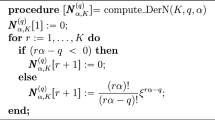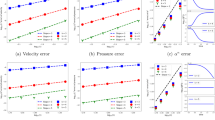Abstract
The generalized Graetz problem refers to stationary convection–diffusion in uni-directional flows. In this contribution we demonstrate the analyticity of generalized Graetz solutions associated with layered domains: either cylindrical (possibly concentric) or parallel. Such configurations are considered as prototypes for heat exchangers devices and appear in numerous applications involving heat or mass transfer. The established framework of Graetz modes allows to recast the 3D resolution of the heat transfer into a 2D or even 1D spectral problem. The associated eigenfunctions (called Graetz modes) are obtained with the help of a sequence of closure functions that are recursively computed. The spectrum is given by the zeros of an explicit analytical series, the truncation of which allows to approximate the eigenvalues by solving a polynomial equation. Graetz mode computation is henceforth made explicit and can be performed using standard software of formal calculus. It permits a direct and mesh-less computation of the resulting solutions for a broad range of configurations. Some solutions are illustrated to showcase the interest of mesh-less analytical derivation of the Graetz solutions, useful to validate other numerical approaches.




Similar content being viewed by others
References
Arnold V (1973) Ordinary differential equations, 10th edn. MIT Press, Cambridge
Bouyssier J, Pierre C, Plouraboué F (2014) Mathematical analysis of parallel convective exchangers with general lateral boundary conditions using generalized Graetz modes. Math Models Methods Appl Sci 24(04):627–665
Debarnot V, Fehrenbach J, de Gournay F, Martire L (2018) The case of Neumann, robin and periodic lateral condition for the semi infinite generalized Graetz problem and applications. arXiv preprint arXiv:1803.00834
Deen WM. Analysis of transport phenomena. Oxford University Press, New York
Dichamp J, Gournay FD, Plouraboué F (2017) Theoretical and numerical analysis of counter-flow parallel convective exchangers considering axial diffusion. Int J Heat Mass Transf 107:154–167
Dorfman A, Renner Z (2009) Conjugate problems in convective heat transfer. Math Probl Eng 2009:927350
Fedorov AG, Viskanta R (2000) Three-dimensional conjugate heat transfer in the microchannel heat sink for electronic packaging. Int J Heat Mass Transf 43(3):399–415
Fehrenbach J, De Gournay F, Pierre C, Plouraboué F (2012) The generalized Graetz problem in finite domains. SIAM J Appl Math 72:99–123
Gostoli C, Gatta A (1980) Mass transfer in a hollow fiber dialyzer. J Membr Sci 6:133–148
Graetz L (1885) Uber die Wärmeleitungsfähigkeit von Flüssigkeiten. Ann Phys 261(7):337–357
Ho C-D, Yeh H-M, Yang W-Y (2002) Improvement in performance on laminar counterflow concentric circular heat exchangers with external refluxes. Int J Heat Mass Transf 45(17):3559–3569
Ho C-D, Yeh H-M, Yang W-Y (2005) Double-pass flow heat transfer in a circular conduit by inserting a concentric tube for improved performance. Chem Eng Commun 192(2):237–255
Hong C, Asako Y, Suzuki K (2011) Convection heat transfer in concentric micro annular tubes with constant wall temperature. Int J Heat Mass Transf 54(25):5242–5252
Kragh J, Rose J, Nielsen TR, Svendsen S (2007) New counter flow heat exchanger designed for ventilation systems in cold climates. Energy Build 39(11):1151–1158
Nunge RJ, Gill WN (1965) Analysis of heat or mass transfer in some countercurrent flows. Int J Heat Mass Transf 8(6):873–886
Nunge RJ, Gill WN (1966) An analytical study of laminar counterflow double-pipe heat exchangers. AIChE J 12(2):279–289
Pierre C, Bouyssier J, De Gournay F, Plouraboué F (2014) Numerical computation of 3d heat transfer in complex parallel heat exchangers using generalized Graetz modes. J Comput Phys 268:84–105
Pierre C, Plouraboué F (2009) Numerical analysis of a new mixed formulation for eigenvalue convection–diffusion problems. SIAM J Appl Math 70(3):658–676
Plouraboué F, Pierre C (2007) Stationary convection–diffusion between two co-axial cylinders. Int J Heat Mass Transf 50(23):4901–4907
Qu W, Mudawar I (2002) Analysis of three-dimensional heat transfer in micro-channel heat sinks. Int J Heat Mass Transf 45(19):3973–3985
Qu W, Mudawar I (2002) Experimental and numerical study of pressure drop and heat transfer in a single-phase micro-channel heat sink. Int J Heat Mass Transf 45(12):2549–2565
Ross SL (1964) Differential equations. Blaisdell Publishing Company Ginn and Co, New York
Shah RK, Sekulic DP (2003) Fundamentals of heat exchanger design. Wiley, New York
Tu J-W, Ho C-D, Chuang C-J (2009) Effect of ultrafiltration on the mass-transfer efficiency improvement in a parallel-plate countercurrent dialysis system. Desalination 242(1–3):70–83
Vera M, Liñán A (2010) Laminar counterflow parallel-plate heat exchangers: exact and approximate solutions. Int J Heat Mass Transf 53(21):4885–4898
Weisberg A, Bau HH, Zemel J (1992) Analysis of microchannels for integrated cooling. Int J Heat Mass Transf 35(10):2465–2474
Yeh H (2009) Numerical analysis of mass transfer in double-pass parallel-plate dialyzers with external recycle. Comput Chem Eng 33(4):815–821
Yeh H (2011) Mass transfer in cross-flow parallel-plate dialyzer with internal recycle for improved performance. Chem Eng Commun 198(11):1366–1379
Author information
Authors and Affiliations
Corresponding author
Ethics declarations
Conflict of interest
The authors declare that they have no conflict of interest
Additional information
Publisher's Note
Springer Nature remains neutral with regard to jurisdictional claims in published maps and institutional affiliations.
Appendix
Appendix
1.1 Cylindrical heated pipe case \(Q\ne 0\)
The solution provided by (20) is
Rewritting (28) as
with H(z) the Heaviside function, and using integration by parts leads to the primitive \(G(z)=\int _{-\infty }^{z} g(z')dz'\) equals to
The function \(c_{i}(z)\) in (33) are given by (23), the integration by part of which gives
The eigenfunctions \(T_i\) are provided by the \(\lambda\)-analytical decomposition (10) upon functions \(t_p(r)\) such that
where each eigenvalue \(\lambda _i\) of the discrete spectrum sets its eigenfunctions \(T_i\) from (34). Here, Neumann adiabatic boundary condition at \(R=2\), combined with—truncated—decomposition (34) provide a—hence finite—polynomial condition for \(\lambda _i\) whose zeros are the approximated discrete spectrum. We hereby provide the first three elements of both downstream and upstream spectrum computed with finite truncation \(N_p=20\) in (34) and parameter \(Pe=1\), with a formal calculus Maple software: \(\lambda _1 = 0.674240\), \(\lambda _2 =3.306258\), \(\lambda _3 =4.936416\), \(\lambda _{-1} =0\), \(\lambda _{-2} =-1.027741\), \(\lambda _{-3} =-2.35726\). Function \(t_p(r)\), \(p\in \{0,5\}\) are also hereby given by the following piece-wise continuous analytic functions of r along the fluid-solid domains \(r \in [0,1] \cup [1,2]\)
Finally, each parameter \(\alpha _i\) of (33) is given by (22) using the closure function \(T_i(R=2)\) and its corresponding eigenvalue \(\lambda _i\).
1.2 Parallel configuration and balanced case \(Q=0\)
The theoretical solution detailed in Sect. 4.1.3 is hereby detailed. From (25) we recall the temperature solution
involving the constant a given in (32) and the function g(z) given in (28). Rewritting (28) as
with H(z) the Heaviside function, and using integration by parts leads to a primitive \(G(z)=\int _{-\infty }^{z} g(z')dz'\) equals to
Again, the functions \(c_{i}(z)\) are given by (23), the integration by part of which gives
The eigenfunctions \(T_i\) are provided by the \(\lambda\)-analytical decomposition (10) upon functions \(t_p(r)\) such that
where each eigenvalue \(\lambda _i\) of the discrete spectrum sets its eigenfunctions \(T_i\) from (37). Here again, Neumann boundary condition at \(R=\pm 2\), combined with—truncated—decomposition (37) provide a polynomial condition for \(\lambda _i\) the zeros of which are the approximated discrete spectrum. We hereby provide the five first elements of this spectrum computed with finite truncation \(N_p=20\) in (37) and parameter \(Pe=50\), computed with a formal calculus Maple software. \(\lambda _1 = -1.738793\), \(\lambda _2 = -1.738793\), \(\lambda _3 = -1.585275\), \(\lambda _4 =-1.3093020\), \(\lambda _5 = -1.011529\). Function \(t_p(r)\), \(p\in \{0,5\}\) are also hereby given by the following piece-wise continuous polynomial functions of r along the various solid-fluid domains \([-2,-1] \cup [-1,0] \cup [0,1] \cup [1,2]\). Starting with \(t_0=1\) identically equal to 1, we recursively compute the following (polynomial) functions \(t_p(r)\)
Parameter \(\alpha _i\) of (36) is given by (22) using closure function \(T_i(R=2)\) and its corresponding eigenvalue \(\lambda _i\).
Rights and permissions
About this article
Cite this article
Pierre, C., Plouraboué, F. Analytical properties of Graetz modes in parallel and concentric configurations. Meccanica 55, 1545–1559 (2020). https://doi.org/10.1007/s11012-020-01192-4
Received:
Accepted:
Published:
Issue Date:
DOI: https://doi.org/10.1007/s11012-020-01192-4




